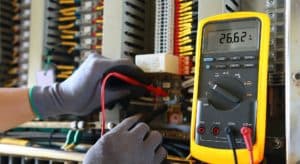Have you ever wondered why a flashlight or a car light slowly dim instead of turning off when they run out of power? This gradual dimming phenomenon can be explained by the physics concepts of electromotive force (emf) and internal resistance.
If you have heard of these concepts before, but aren’t sure exactly what they are, you may have questions like “what is an electromotive force in physics”, “what is internal resistance” and “how to find electromotive force”.
In this article, we will answer these questions and more. You will be provided with the essential knowledge to fully understand the concepts of electromotive force and internal resistance.
Electromotive Force in Physics
The concept of electromotive force is an important thing to know in physics. Before we start looking for the answer to the question “what is an electromotive force?”, let’s first talk about electric potential difference.
You have probably seen the term electric potential difference before but might not know what it actually means. Electric potential difference can be described as the voltage, or the work required to move a charge between two points in an electric field. Any voltage source, such as a battery cell, can generate a potential difference and current flow if it is connected in a complete circuit containing electrical loads.
An electromotive force, also known as emf, describes a type of potential difference that is related to an electrical source or voltage supply of some kind. It is important to note that emf if not related to the other concept of forces in physics (i.e. the forces that are measured in newtons). In this sense, electromotive force is not really a force at all. Instead, the unit for emf is the volt, symbolized by the letter V. It is the electric potential differential that can be imparted by an energy source when there is no current flowing through it.
There are many devices that can provide an electromotive force, such as electrochemical cells, solar cells, and electrical generators.
Let’s look at one of the most common types of electrochemical cells, the Daniell cells. A Daniell cell consists of two half-cells. One of the half-cells contains zinc metal as its electrode, and zinc sulfate as its electrolyte. When the zinc electrode dissolves in the sulfate solution, it creates many positive zinc ions and free electrons in the solution. The other half-cell contains a copper electrode, and copper sulfate solution. The copper ions in the copper sulfate solution receive electrons from the copper electrode, creating a deficit of electrons in this half-cell. The imbalance of electrons causes electrons to flow between the two half-cells, generating an emf.
You can see a a simple diagram of a Daniell cell below. Notice the flow of electrons between the two half-cells.

“Galvanic cell labeled.svg” by Rehua is licensed under CC BY 3.0
What is a Source of Electromotive Force?
Now that we’ve talked about the definition of electromotive force in physics, let’s discuss what an emf source is and then look at some examples.
An emf source or voltage source can be described as a charge pump that moves charges from one terminal to the other. An emf source will move negative charges or electrons out of its negative terminal. These charges or electrons will then move around the circuit and get attracted to the positive terminal of the emf source.
A complete circuit is required for electrons to move. If the circuit connecting the two terminals of the voltage source is broken or disconnected, the flow of electrons will stop and no electrical energy will be generated.
An example of an emf source is an electric battery. A battery cell has two terminals: the positive terminal has a higher electric potential and the negative terminal has a lower electric potential. When connected to a complete circuit, a battery converts chemical energy into electrical energy and supplies power to its load by forcing electrons to move from its negative terminal, through the circuit, and towards its positive terminal.
Other devices that can act as sources of emf include transformers, electrical generators and photovoltaic cells.
Internal Resistance
As stated previously, the voltage output of a voltage source is equal to its emf only if there is no current flowing through it.
In the case that there is current flowing through a voltage source, the value of the emf will be different from the voltage across the two terminals of the voltage source. The reason for the difference is because the voltage source contains internal resistance across which there is a voltage drop.
Internal resistance is the resistance of a non-ideal voltage source. All voltage sources in reality will have an internal resistance value and this resistance will have an effect on the circuit to which it is connected. Due to the internal resistance, some of the electrical energy is converted to heat when current flows through the voltage source to its terminals. This is why your car battery gets warmer when charging.
Many factors can affect the magnitude of the internal resistance of a voltage source. For instance, battery temperature and even the state of its charge can affect internal resistance. As the internal resistance of a battery increases, its voltage output decreases for a given current value. This explains why a flashlight may become dimmer and dimmer as its battery heats up.
Other factors like the current flowing through the voltage source, dimensions, chemistry of the voltage source, and the number of charge/discharge cycles of a rechargeable voltage source can also affect internal resistance.
Terminal Voltage
The terminal voltage of a voltage source is related to electromotive force, so let’s talk about terminal voltage before we move on to some calculations. The terminal voltage is the voltage across the two terminals of a voltage source when it is not connected to any load. Ideally, a voltage source should have zero internal resistance and its terminal voltage would be equal to its emf regardless of the current flowing through it.
How to Find Electromotive Force
Let’s take a look at the formula for electromotive force so we can calculate what the emf will be when it is under a certain load. We will see how the terminal voltage, current, and internal resistance play a role in determining the electromotive force.
The formula for electromotive force is:
ε = Vterminal + Ir
Where:
- ε is the electromotive force
- Vterminal is the terminal voltage
- I is the current flowing through the circuit out of the voltage source
- r is the internal resistance of the voltage source
From this equation, we can see that terminal voltage decreases as current increases or internal resistance increases, while the electromotive force of a source remains constant.
Here is an example problem for you to try out using this equation. Suppose that you have a battery with an emf of 10V and an internal resistance of 0.1 Ω. What is the maximum allowable current that can flow through the battery if the terminal voltage must be greater than 5V? In this example, we assume that the load resistance is zero. However, note that this is not the case in many real-life scenarios. Make sure to consider the load resistance when necessary.
Since we have Vterminal > 5V and Vterminal = ε – Ir, this means that the difference between the value of the emf and the voltage drop must be greater than 5V:
ε – Ir > 5V
Ir < ε – 5V
I < (ε – 5V)/r
Then, by entering the known values for emf and internal resistance into the equation, we get:
I < (10V – 5V)/0.1 Ω
I < 50 A
After entering in all our values, we can see that the magnitude of current must be less than 50A to get a terminal voltage larger than 5V.
Conclusion
The concept of the electromotive force can be confusing at first, but to make progress with electronics and electrical systems, it is essential to understand both the behavior of electrical circuits and other phenomena within the field, such as Faraday’s Law.
From this article, you should understand the fundamental concept of emf, what its sources are, how to calculate it and how it relates to the concepts of voltage and potential difference. You also are now aware of the fact that real world sources of emf are subject to some internal resistance, and you may need to take this into consideration in your electronics designs. You should be ready to properly understand what exactly emf and terminal voltage are when you hear them discussed online, in documentation, in the workplace, or in a classroom.
Join our Tech Tribe Community and be the first to learn important global tech news and improve your skills in engineering/robotics/3D printing, and more. Continue to quickly learn all the knowledge you need for DIY electronics or your college program with our Learning Hub.











